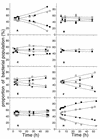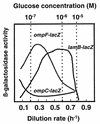Regulation of porin-mediated outer membrane permeability by nutrient limitation in Escherichia coli
- PMID: 9683489
- PMCID: PMC107376
- DOI: 10.1128/JB.180.15.3917-3922.1998
Regulation of porin-mediated outer membrane permeability by nutrient limitation in Escherichia coli
Abstract
OmpF and OmpC porins were differentially regulated by nutrient limitation and growth rate in glucose- or nitrogen-limited chemostat cultures of Escherichia coli. Transcriptional and translational ompF fusions showed a sharp peak of expression under glucose limitation at D = 0.3 h-1, with lower amounts at lower and higher growth rates. The peak of OmpR-dependent transcriptional stimulation of ompF under glucose limitation in minimal salts media was about 20-fold above nutrient excess levels and 3-fold higher than that achieved with low osmolarity. Analysis of outer membrane protein levels and results of growth competition experiments with porin mutants were consistent with the enhanced role of OmpF under glucose limitation, but not N limitation. In contrast, OmpC was the major porin under N limitation but was increasingly expressed under glucose limitation at very low growth rates approaching starvation, when OmpF was downregulated. In summary, outer membrane permeability under N-limited, sugar-rich conditions is largely based on OmpC, whereas porin activity is a complex, highly sensitive function of OmpF, OmpC, and LamB glycoporin expression under different levels of glucose limitation. Indeed, the OmpF level was more responsive to nutrient limitation than to medium osmolarity and suggested a significant additional layer of control over the porin-regulatory network.
Figures




Similar articles
-
An analysis of multifactorial influences on the transcriptional control of ompF and ompC porin expression under nutrient limitation.Microbiology (Reading). 2001 Nov;147(Pt 11):2981-9. doi: 10.1099/00221287-147-11-2981. Microbiology (Reading). 2001. PMID: 11700349
-
The leucine-responsive regulatory protein of Escherichia coli negatively regulates transcription of ompC and micF and positively regulates translation of ompF.J Bacteriol. 1995 Jan;177(1):103-13. doi: 10.1128/jb.177.1.103-113.1995. J Bacteriol. 1995. PMID: 8002608 Free PMC article.
-
Regulation of ompF porin expression by salicylate in Escherichia coli.J Bacteriol. 1991 Sep;173(18):5631-8. doi: 10.1128/jb.173.18.5631-5638.1991. J Bacteriol. 1991. PMID: 1715858 Free PMC article.
-
From acids to osmZ: multiple factors influence synthesis of the OmpF and OmpC porins in Escherichia coli.Mol Microbiol. 1996 Jun;20(5):911-7. doi: 10.1111/j.1365-2958.1996.tb02532.x. Mol Microbiol. 1996. PMID: 8809744 Review.
-
Signal transduction and gene regulation through the phosphorylation of two regulatory components: the molecular basis for the osmotic regulation of the porin genes.Mol Microbiol. 1990 Jul;4(7):1077-82. doi: 10.1111/j.1365-2958.1990.tb00681.x. Mol Microbiol. 1990. PMID: 1700256 Review.
Cited by
-
Putative porin of Bradyrhizobium sp. (Lupinus) bacteroids induced by glyphosate.Appl Environ Microbiol. 2007 Aug;73(16):5075-82. doi: 10.1128/AEM.00392-07. Epub 2007 Jun 8. Appl Environ Microbiol. 2007. PMID: 17557843 Free PMC article.
-
Structural and Functional Diversity of Resistance-Nodulation-Cell Division Transporters.Chem Rev. 2021 May 12;121(9):5378-5416. doi: 10.1021/acs.chemrev.0c00621. Epub 2020 Nov 19. Chem Rev. 2021. PMID: 33211490 Free PMC article. Review.
-
Physiological, biomass elemental composition and proteomic analyses of Escherichia coli ammonium-limited chemostat growth, and comparison with iron- and glucose-limited chemostat growth.Microbiology (Reading). 2015 Aug;161(8):1659-1670. doi: 10.1099/mic.0.000118. Epub 2015 May 26. Microbiology (Reading). 2015. PMID: 26018546 Free PMC article.
-
Microfluidic approaches in microbial ecology.Lab Chip. 2024 Feb 27;24(5):1394-1418. doi: 10.1039/d3lc00784g. Lab Chip. 2024. PMID: 38344937 Free PMC article. Review.
-
MzrA: a novel modulator of the EnvZ/OmpR two-component regulon.Mol Microbiol. 2009 Jun;72(6):1408-22. doi: 10.1111/j.1365-2958.2009.06728.x. Epub 2009 May 8. Mol Microbiol. 2009. PMID: 19432797 Free PMC article.
References
-
- Andersen J, Delihas N. micF RNA binds to the 5′ end of ompF mRNA and to a protein from Escherichia coli. Biochemistry. 1990;29:9249–9256. - PubMed
-
- Ferenci T. Adaptation to life at micromolar nutrient levels: the regulation of Escherichia coli glucose transport by endoinduction and cAMP. FEMS Microbiol Rev. 1996;18:301–317. - PubMed
Publication types
MeSH terms
Substances
LinkOut - more resources
Full Text Sources
Other Literature Sources
Molecular Biology Databases

